Documents: Go to download!
User Manual
- User Manual - (English)
- Quick Specs - (English)
- Installation Instruction - (English)
- Energy Guide - (English)
- Literature - (English)
- Operating Instructions
- Before you call for service…
Table of contents
User manual Dishwasher
Operating Instructions
About the dishwasher control panel.
You can locate your model number on the tub wall just inside the door. Throughout this manual, features and appearance may vary from your model.

Control Settings
1. Load Selections
The light above the selected pad will be ON to indicate which LOAD SELECTION has been selected.
POTS & PANS For heavily soiled dishes or cookware with dried-on or baked-on soils. Everyday dishes may be included. This cycle will not remove burned-on foods.
NORMAL For loads of everyday dishes and glassware with medium soils.
LIGHT WASH For dishes with light soils.
CHINA CRYSTAL For lightly soiled china and crystal.
RINSE ONLY For rinsing partial loads that will be washed later. Do not use detergent with this cycle.
2. Options
The light above the selected pad will be ON to indicate which OPTION has been selected.
HI TEMP Turns on the heater in all postrinse and final rinse cycles to help prevent spotting
RINSE on dishware. This option may be turned ON or OFF during the wash cycle.
HI TEMP Energizes the heater to boost water temperature in all prewash and main wash fill
WASH cycles. Recommended for use with heavily soiled dishes. Option may be turned ON
or OFF during the wash cycle.
HEATED DRY Shuts off the drying heat option. Dishes air dry naturally and energy is saved. You
OFF can prop the door open after the CLEAN light illuminates.
HEATED DRY Turns the heater on for fast drying. This cycle will extend the time to your wash
ON cycle by 30 minutes. NOTE: Cannot be selected with RINSE ONLY cycle.
LOCK When the LOCK pad is touched twice within 3 seconds, all pads become inoperative. You can lock the controls to prevent any selections from being made. Or you can lock the controls after you have started a cycle or selected DELAY START so the cycle or DELAY START is not interrupted.
Children cannot accidentally start dishwasher by touching pads with this option selected.
To unlock the dishwasher after it has been locked, touch the LOCK pad twice within 3 seconds. The light above the LOCK pad will turn off.
DELAY START You can delay the start of a wash cycle for up to 8 hours. Press the DELAY START pad to choose the number of hours you want to delay the start of the cycle. The machine will count down and start automatically at the correct time. Pressing the START/RESET button will cancel the DELAY START selection.
NOTE: If you forget to latch the door a reminder signal will beep until you do so.
RESET To change a cycle after washing starts, touch the START/RESET pad to cancel the cycle. After water is pumped out and the motor stops, you can reprogram and restart the dishwasher. This will take approximately 90 seconds.
3. Start
Close and latch the door. Touch the START/RESET pad to begin the cycle. Water fill begins and approximately 40 seconds later the wash action begins.
NOTE: The dishwasher remembers your last cycle so you don’t have to reprogram each time. When the dishwasher is loaded and the door latch is in the locked position, the control panel lights will be ON and display the last settings you selected.
If you don’t want to change any of the settings, simply touch the START/RESET
pad to begin the cycle.
Also, if a power failure occurs, NORMAL and HEATED DRY will automatically be programmed. Make any new selections and touch the START/RESET pad to begin the cycle.
4. Clean
This light is illuminated when a wash cycle is complete. The light will stay ON until the door is opened.
Flashing display lights.
| Lights | What It Means | What To Do |
 | This is normal. The START/RESET pad has been pressed. | Allow the dishwasher to drain and reset before you start a new wash cycle. |
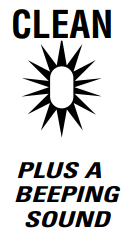 | Control Error | Press the START/RESET pad to turn off the beeper. If the CLEAN light continues to flash, call for service. |
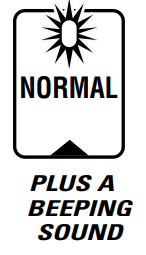 | Control Error | Press the START/RESET pad to turn off the beeper and the dishwasher will attempt to reset. Then restart the wash cycle. If this error continues, call for service. |
Using the dishwasher.
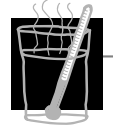 Check the Water Temperature
Check the Water Temperature
The entering water must be at least 120°F. and not more than 150°F., for effective cleaning and to prevent dish damage. Check the water temperature with a candy or meat thermometer. Turn on the hot water faucet nearest the dishwasher, place the thermometer in a glass and let the water run continuously into the glass until the temperature stops rising.
 Use Jet-Dry ® Rinse Agent
Use Jet-Dry ® Rinse Agent
Jet-Dry® rinse agent removes spots and prevents new film build-up on your dishes, glasses, flatware, cookware and plastic.
Fill the rinse agent dispenser until it reaches the bottom of lip
inside the opening. Do not overfill the dispenser. Replace cap.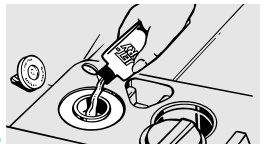
To check if rinse agent is needed, press the clear center of the fill cap
2 or 3 times. If rinse agent fills the center of the fill cap, you have enough.
A full dispenser should last about one month. If rinse agent is spilled, wipe up the excess.
Dish Preparation Prior to Loading
- No pre-rinsing of normal food soil is required.
- Scrape off hard soils, including bones, toothpicks, skins, and seeds.
- Remove large quantities of any remaining food.
- Remove leafy vegetables, meat trimmings, and excessive amounts of grease or oil.
- Remove acidic food soils that can discolor stainless steel.
Using the Dishwasher Door
- The door must be closed and locked into place to select a LOAD SELECTION or an OPTION.
- If the door is opened during a cycle and left open, the dishwasher will beep once every minute until the door is closed and latched into place.
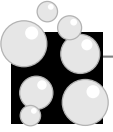 Proper Use of Detergent
Proper Use of Detergent
Use only detergent specifically made for use in dishwashers. Cascade® Automatic Dishwashing Detergent has been approved for use in all GE dishwashers. Keep your detergent fresh and dry. Don’t put detergent into the dispenser until you’re ready to wash dishes.
You’ll find two detergent dispensers on the inside door of your dishwasher. All wash cycles require detergent in the main cup. Wash cycles with a pre-wash and a main wash will also use the open cup. The amount of detergent to use depends on whether your water is hard or soft. With hard water, fill the main cup and open cup completely. With soft water, fill both cups halfway. When using automatic dishwashing detergent tabs, simply place one tab in the main cup and close. 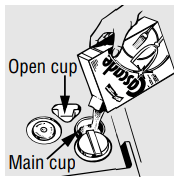
Protect your dishes and dishwasher by contacting your water department and asking how hard your water is. Twelve or more grains is extremely hard water. A water softener is recommended. Without it, lime can build up in the water valve, which could stick while open and cause flooding. Too much detergent with soft water can cause a permanent cloudiness of glassware, called etching.
NOTE: To open detergent cup after it has been closed, unlatch the door. Press the START/RESET pad three times within two seconds and the detergent cup will release.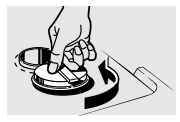
You may also turn the detergent cup handle counter-clockwise until it releases. A snapping sound may be heard.
 Forget to Add a Dish?
Forget to Add a Dish?
A forgotten dish can be added any time before the main wash.
- Push the door latch to the left.
- Do not open the door until the water spray action stops. Steam may rise out of the dishwasher.
- Add forgotten dishes.
- Close the door and push the latch to the far right.
Loading the dishwasher racks.
For best dishwashing results, follow these loading guidelines. Features and appearance of racks and silverware baskets may vary from your model.
Upper Rack
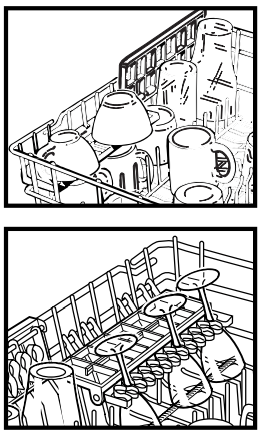
The upper rack is for glasses, cups and saucers. Cups and glasses fit best along the sides. This is also a secure place for dishwasher-safe plastics.
The cup shelf (on some models) may be placed in the up or down position to add flexibility.
A wine glass holder (on some models) secures wine glasses at an angle for best washability. Because wine glasses come in various sizes, after loading, slowly push in the rack to make sure they will clear the top of the dishwasher.
The upper rack is good for all kinds of odd-shaped utensils. Saucepans, mixing bowls and other items should be placed face down. Fold-down fingers (on some models) provide flexibility for
extra-large and hard-to-fit items.
Secure larger dishwasher-safe plastics over two fingers when possible.
Make sure small plastic items are secure so they can’t fall onto the heater.
Be sure that items do not protrude through the bottom of the rack and block rotation of the middle spray arm. This could result in poor wash performance for items in the upper rack.
Check to make sure that tall items will not block rotation of the top wash arm.
The Wash Tower
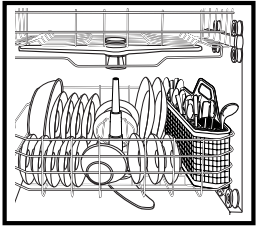
Keep the center area clear in the lower rack.
The wash tower rises through the center of the lower rack during the wash and rinse portions of the cycle. The wash tower shoots water into the mid-level wash arm located under the upper rack. Blocking the wash tower could result in poor wash performance for items in the upper rack.
 Don’t block or load tall things next to the Wash Tower.
Don’t block or load tall things next to the Wash Tower.
Lower Rack
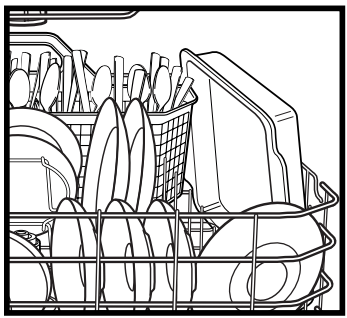
When loading the lower rack, do not load large platters or trays in the front right corner. They may prevent detergent from circulating during the wash cycle.
The lower rack is best used for plates, saucers, and cookware. Large items such as broiler pans and racks should go along the right-hand side. Load platters, pots and bowls along the sides, in corners, or in the back. The soiled side of items should face the center of the rack.
Also, be careful not to let a portion of an item such as a pot or dish handle extend through the bottom rack. This could block the wash arm and result in poor wash performance.
Fold-down fingers (on some models) provide flexibility for extra-large and hard-to-fit items.
The fingers may be left in the up position or folded down to customize the lower rack.
Silverware Basket
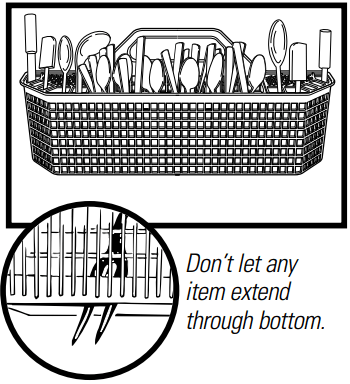
Put flatware in the removable basket with knife handles up to protect your hands. Place spoons in the basket with handles down. Mix knives, forks and spoons so they don’t nest together. Distribute evenly. Small plastic items, such as measuring spoons and lids from small containers, should go in the bottom of the silverware basket with silverware on top.
Lids can be assembled to either end of the silverware basket to contain small items.
To assemble an end lid, place the outer lid stud into the hole on the outside of the silverware basket. Then place the inside lid stud into the inner hole in the silverware basket. Repeat for other side if desired. Long items can be placed on the cupshelf in the upper rack.
The silverware basket can be placed in the front, side or back of the lower rack.
Loading 10 place settings…
Follow these guidelines for loading 10 place settings. Features and appearance of racks and silverware baskets may vary from your model.

About optional accessories.
You can change the door and lower access panel appearance of your dishwasher by ordering one of these optional accessories:
- Color Panels
- 1/4” Wood Panel Trim Kit
- 3/4” Trimless Panel Kit
These accessories are available at extra cost (VISA, MasterCard, or Discover cards accepted) by calling 800-626-2002.
Specify accessory number when ordering.
 Descriptions of Optional Accessories
Descriptions of Optional Accessories
Color panels— Replacement door panels and lower access panels are available in the following colors:
- GPF400A (Almond)
- GPF400B (Black)
- GPF400W (White)
- GPF400S (Stainless Steel)
- GPF400C (Bisque)
NOTE: The GPF100 dishwasher door spring kit is included with the stainless steel color panel kit and must be installed with it (GPF400S).
Wood panel trim kit— This accessory contains trim and instructions for you to supply and install a 1⁄4² thick decorative wood door and lower access panel:
- GPF425A (Almond)
- GPF425B (Black)
- GPF425W (White)
- GPF425C (Bisque)
NOTE: The GPF100 dishwasher door spring kit must also be ordered and installed when the door panel weighs four lbs. or more.
Trimless panel kit— This accessory contains parts and instructions for you to supply and install a 3⁄4² thick decorative wood door and lower access panel:
- GPF475
NOTE: The GPF100 dishwasher door spring kit is included with the trimless panel kit and must be installed with it.
Caring for the dishwasher
To clean the control panel use a lightly dampened cloth then dry thoroughly. To clean the exterior use a good appliance polish wax.
Never use sharp objects, scouring pads or harsh cleaners on any part of the dishwasher.
Protect Against Freezing
If your dishwasher is left in an unheated place during the winter, ask a service technician to:
- Cut off electrical power to the dishwasher. Remove fuses or trip circuit breaker.
- Turn off the water supply and disconnect the water inlet line from the water valve.
- Drain water from the water inlet line and water valve. (Use a pan to catch the water.)
- Reconnect the water inlet line to the water valve.
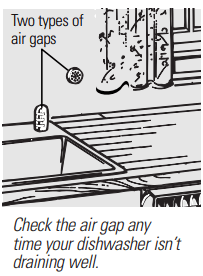 Does Your Dishwasher Have an Air Gap?
Does Your Dishwasher Have an Air Gap?
An air gap protects your dishwasher against water backing up into it if a drain clogs. The air gap is not a part of the dishwasher. It is not covered by your warranty. Not all plumbing codes require air gaps, so you may not have one.
The air gap is easy to clean.
- Turn off the dishwasher and lift off the chrome cover.
- Remove the plastic cap and clean with a toothpick.
The Stainless Steel Panels
The stainless steel panels can be cleaned with Stainless Steel Magic or a similar product using a clean, soft cloth.
You can order Stainless Steel Magic # WX10X15 through GE Parts by calling 800-626-2002.
Before you call for service…
Troubleshooting Tips Review the charts on the following pages first and you may not need to call for service.
Problem | Possible Causes | What To Do |
Control panel lights go off when you’re setting controls | Time too long between touching of selected pads | • Each pad must be touched within 30 seconds of the others. To relight, touch any pad again, or unlock and relatch door. |
Noise | Some of the sounds you’ll hear are normal shredding action. | • Hard food disposal •Drain valve opening to pump water out. •Timer control as cycle progresses. •Detergent cup opening. •The motor stopping during the drying period. •Water draining out of the tub immediately after you touch START/RESET pad. |
Utensils are not secure • Make sure everything is in the rack or something secured in dishwasher. small has dropped into the rack | ||
| Motor hums | • Dishwasher has not been used on a regular basis. If you do not use your dishwasher often, set it to fill and pump out once every week. This will help keep the seal moist and the garbage disposer clear. | |
Detergent left in dispenser cups | Dishes are blocking the detergent cups | • Reposition the dishes.
|
Detergent cup lid latched accidentally by user |
| •Unlatch the door. Press the START/RESET pad three times within two seconds. The detergent cup will trip. |
Water standing in the bottom of the tub | This is normal | •A small amount of clean water around the outlet on the tub bottom at the back of the tub keeps the water seal lubricated. |
Water won’t pump out of the tub | Drain is clogged | •If you have an air gap, clean it. •Check to see if your kitchen sink is draining well. If not, you may need a plumber. •If the dishwasher drains into a disposer, run disposer clear. |
Suds in the tub | Correct detergent wasn’t used
| •Use only automatic dishwasher detergents to avoid sudsing. Cascade® Automatic Dishwashing Detergent has been approved for use in all GE dishwashers. •To remove suds from the tub, open the dishwasher and let suds dissipate. Add 1 gallon of cold water to the tub. Close the door until it locks into place. Pump out water by pressing START/RESET, then immediately press START/RESET again. Repeat if necessary. |
| Rinse agent was spilled | •Always wipe up rinse agent spills immediately. | |
Stained tub interior | Detergent with colorant was used
| •Some detergents contain colorant (pigment or dyes) that will discolor the tub interior with extended use. Check the detergent cup for signs of any discoloration. If cup is discolored, change to detergent without any colorant. Cascade® Automatic Dishwashing Detergent has been approved for use in all GE dishwashers. . |
| Some tomato-based foods can stain | •Use of the RINSE ONLY cycle (on some models) after adding the dish to the load can decrease the level of staining |
Dishes and flatware not clean | Low inlet water temperature | •Make sure inlet water temperature is correct (see page 12). •Use HI TEMP WASH. |
| Water pressure is temporarily low | •Turn on a faucet. Is water coming out more slowly than usual? If so, wait until pressure is normal before using your dishwasher. | |
| Air gap is clogged | •Clean the air gap. | |
| Improper rack loading | •Make sure large dishware does not block the detergent dispenser or the wash arms. | |
Spots and filming on glasses and flatware | Extremely hard water Low inlet water temperature Overloading the dishwasher Improper loading Old or damp powder detergent Rinse agent dispenser empty Too little detergent | • Use Jet-Dry® rinse agent to remove spots and prevent new film build-up. • To remove stubborn spots and pre-existing film from glassware: 1 Remove all metal utensils from the dishwasher. 2 Do not add detergent. 3 Select the longest cycle. 4 Start the dishwasher and allow to run for 18 to 22 minutes. Dishwasher will now be in the main wash. 5 Open the door and pour 2 cups (500 ml) of white vinegar into the bottom of the dishwasher. 6 Close the door and allow to complete the cycle. If vinegar rinse doesn’t work: Repeat as above, except use 1/4 cup (60 ml) of citric acid crystals instead of vinegar. |
Cloudiness on glassware | Combination of soft water and too much detergent
| •This is called etching and is permanent. To prevent this from happening, use less detergent if you have soft water. Wash glassware in the shortest cycle that will get them clean. |
| Water temperature entering the dishwasher exceeds 150°F. | •Lower the water heater temperature. | |
Black or gray marks on dishes | Aluminum utensils have rubbed against dishes | •Remove marks with a mild, abrasive cleaner. |
Yellow or brown film on inside surfaces | Tea or coffee stains
| •Remove the stain by hand, using a solution of 1/2 cup bleach and 3 cups warm water. WARNING Before cleaning interior wait at least 20 minutes after a cycle for the heating element to cool down. Failure to do so can result in burns. |
| An overall yellow or brown film can be caused by iron deposits in water | •A special filter in the water supply line is the only way to correct this problem. Contact a water softener company. | |
White film on inside surfaces | Hard water minerals | • To clean the interior, apply dishwasher detergent to a damp sponge. Wear rubber gloves. Do not use any type of cleanser other than dishwasher detergent because it may cause foaming or sudsing. Cascade® Automatic Dishwashing Detergent has been approved for use in all GE dishwashers. |
Dishes don’t dry | Low inlet water temperature
| •Make sure inlet water temperature is correct (see page 12). •Select HI TEMP RINSE and/or HEATED DRY. |
| Rinse agent dispenser is empty | •Check the rinse agent dispenser. | |
Control panel responded to inputs but dishwasher never filled with water | Door latch may not be properly seated | •Call for service. |
Dishwasher won’t run | Fuse is blown, or the circuit breaker tripped | •Replace fuse or reset circuit breaker. Remove any other appliances from the circuit. •Try resetting the START/RESET pad. |
Steam | This is normal | •Steam comes through the vent by the door latch during drying and when water is being pumped out. |
See other models: HTS17HBSARWW TBX25PRBMRWW PFSF5RKZABB JD966WD2WW ESS23XGSAWW
